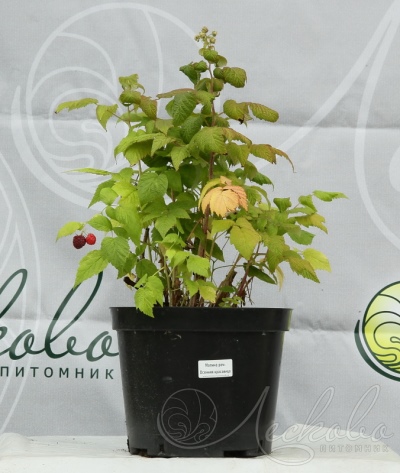
- Authors: Russian selection
- Repairability: Yes
- Berry color: red
- Taste: pleasant, sweet
- Berry weight, g: 4 g, individual up to 10 g
- Yield: 7 kg per bush
- Frost resistance: -28.8 /-23.4
- Appointment: versatile, ideal for fresh consumption, canning or freezing
- Drop off location: sunny, light partial shade allowed
- Fruiting period: from late August to mid-late September
The repairing raspberry Autumn Beauty was obtained by Russian breeders by crossing the varieties Bryanskoe Divo and Daughter of Hercules. Gives fruits for universal use, suitable for freezing, processing and consumption in dessert form. Agrotechnology is relatively simple, the variety is well adapted to the conditions of the middle zone of the Russian Federation.
Description of the variety
Autumn Beauty forms upright, rather compact bushes 100-110 high, up to a maximum of 130 cm. The small plant is covered with an openwork crown. Weakly spiked branch covering does not cause discomfort during harvesting. The thorns are located mainly from the bottom, while the fruits are from the top, which greatly facilitates their removal from the branches.
Ripening terms
Raspberries in the annual cycle bear fruit mainly from the last decade of August to mid or late September.
Yield
Up to 7 kg are collected from the bush. The variety belongs to the category of high yielding raspberries. But it is important to take into account that in the northern regions, plants may not have time to fully harvest. You can bring it to maturity by placing the stems cut from the bush in the water.
Berries and their taste
Autumn Beauty produces large berries of an elongated shape, the average weight of each reaches 4 g, individual - up to 10 g. The color of the skin is bright, red, the pulp is delicate, with a sweet, pleasant taste and rich aroma. According to this indicator, the variety is close to wild raspberries.

Growing features
The variety is drought-resistant, tolerates long periods without rain well. Withstands a drop in atmospheric temperatures down to -28.8 ° C for a short time. Cultivation is carried out mainly in an annual crop, with a harvest on the shoots of the current year. At the end of fruiting, in this case, the entire upper part of the bush is cut off. It does not freeze in winter, provides abundant and friendly one-time fruiting.
In autumn, it is recommended to cover the roots with a thick layer of mulch. When grown in a two-year cycle, the plant requires more attention, needs intensive, enhanced nutrition.
Site selection and soil preparation
Before planting, it is necessary to correctly determine the place for the raspberry tree. Autumn Beauty doesn't like strong winds or drafts, but needs intense sunlight. Landing in partial shade with a long daylight hours is allowed. This variety of raspberries thrives on fertile and light loamy soils with neutral acidity or slightly acidic. Planting is recommended in the autumn, so that the bushes have time to take root, it is carried out until mid-October.
If possible, the raspberry tree is arranged on the south side of the house. This is where the bushes will receive enough sunlight.If the pH is above 6.5, raspberries will not grow successfully. In this case, the soil is deacidified before planting the Autumn Beauty, adding dolomite or lime to it when digging.
Additionally, about 2 buckets of humus are introduced into the soil for each square meter, 250 ml of potassium sulfate or a glass of wood ash, the same amount of superphosphate. After the soil for the raspberry tree has been prepared, you can place the plants. This variety is planted in trenches or separate bushes.


Pruning
Sanitary pruning is carried out in April only if the shoots of the previous year are preserved. It is used as a preventive measure against fungal infections. If the top of the bush was removed in the fall, you won't have to take these measures.

Watering and feeding
Autumn Beauty is a moisture-loving raspberry, especially in need of abundant watering during flowering and fruiting periods. It is important that during this period the soil in the root zone is moistened at least 30 cm in depth. Drip irrigation systems are installed on a large area in raspberries. In compact landings, trenches are dug into which the settled water is supplied from a hose under pressure. It is necessary to exclude the ingress of cold water on the roots.
In springtime, abundant watering of the bushes is carried out. It stimulates active vegetation. When feeding during the planting period, the plants do not require additional fertilization for the next 2 years. Then nitrogen complexes are introduced under the root in the spring, potassium-phosphorus complexes in summer.



Diseases and pests
The variety has a fairly high resistance to diseases and pests. With proper agricultural technology, the risks of infection are minimal.

Unfortunately, raspberries, like other plants, do not bypass various diseases and pests.Only armed with the knowledge and the necessary means for this, you can cope with such troubles. To help the plant, it is very important to be able to recognize the disease in time and begin timely treatment.
Reproduction
The plant does not produce too many root suckers. Raspberry trees do not overgrow, but they are enough for breeding the variety. It is enough to separate the root growth together with a clod of earth, and then transfer it to a new place. Reproduction by cuttings is also possible. In this case, they are separated from the stem or rhizome, and then placed in the ground, treated with stimulating solutions.








































































